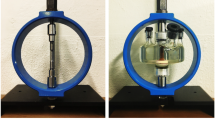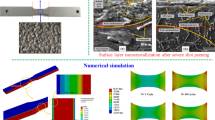Abstract
AISI 304 stainless steel is very widely used for industrial applications due to its good integrated performance and corrosion resistance. However, shot peening (SP) is known as one of the effectual surface treatments processes to provide superior properties in metallic materials. In the present study, a comprehensive study on SP of AISI 304 steel including 42 different SP treatments with a wide range of Almen intensities of 14–36 A and various coverage of 100–2000% was carried out. Varieties of experiments were accomplished for the investigation of the microstructure, grain size, surface topography, hardness and residual stresses as well as axial fatigue behavior. After experimental investigations, artificial neural networks modeling was carried out for parametric analysis and optimization. The results indicated that, treated specimens with higher severity had more desirable properties and performances.













Similar content being viewed by others
References
Amanov A, Karimbaev R, Maleki E, Unal O, Pyun Y, Amanov T (2019) Effect of combined shot peening and ultrasonic nanocrystal surface modification processes on the fatigue performance of AISI 304. Surf Coat Technol 358:695–705
Maleki E, Unal O, Rreza Kashyzadeh K (2018) Effects of conventional, severe, over, and re-shot peening processes on the fatigue behavior of mild carbon steel. Surf Coat Technol 344:62–74
Unal O, Maleki E, Varol R (2018) Effect of severe shot peening and ultra-low tempera-ture plasma nitriding on Ti-6Al-4V alloy. Vacuum 150:69–78
Marteau J, Bigerelle M (2015) Relation between surface hardening and roughness induced by ultrasonic shot peening. Tribol Int 83:105–113
Liu S, Gao SY, Zhou YF, **ng XL, Hou XR, Yang YL, Yang QX (2014) A research on the microstructure evolution of austenite stainless steel by surface mechanical attrition treatment. Mater Sci Eng A 617:127–138
Yin F, Rakita M, Shan Hu, Han Q (2017) Overview of ultrasonic shot peening. Surf Eng 33(9):651–666. https://doi.org/10.1080/02670844.2017.1278838
Luo KY, Yin YF, Wang CY, Chai QF, Cai J, Lua JZ, Lu YF (2019) Effects of laser shock peening with different coverage layers on fatigue behavior and fractural morphology of Fe–Cr alloy in NaCl solution. J Alloys Compd 773:168–179
Lu HF, Luo KY, Wu LJ, Cui CY, Lu JZ (2019) Effects of service temperature on tensile properties and microstructural evolution of CP titanium subjected to laser shock peening. J Alloy Compd 770:732–741
Guagliano M (2001) Relating Almen intensity to residual stresses induced by shot peening: a numerical approach. J Mater Process Technol 110:277–286
Maleki E, Unal O (2018) Roles of surface coverage increase and re-peening on properties of AISI 1045 carbon steel in conventional and severe shot peening processes. Surf Interfaces 11:82–90
Bagherifard S, Fernandez-Pariente I, Ghelichi R, Guagliano M (2013) Effect of severe shot peening on microstructure and fatigue strength of cast iron. Int J Fatigue 65:64–70
Maleki E, Unal O, Amanov A (2018) Novel experimental methods for the determination of the boundaries between conventional, severe and over shot peening processes. Surf Interfaces 13:233–254
Maleki E (2016) Modeling of severe shot peening effects to obtain nanocrystalline surface on cast iron using artificial neural network. Mater Today Proc 3:2197–2206
Unal O, Maleki E, Kocabas I, Yilmaz H, Husem F (2019) Investigation of nanostructured surface layer of severe shot peened AISI 1045 steel via response surface methodology. Measurement 148:106960
Tevlek A, Aydın HM, Maleki E, Varol R, Unal O (2019) Effects of severe plastic deformation on pre-osteoblast cell behavior and proliferation on AISI 304 and Ti-6Al-4V metallic substrates. Surf Coat Technol 366:204–213
Liu C, Zheng H, Gu X, Jiang B, Liang J (2019) Effect of severe shot peening on corrosion behavior of AZ31 and AZ91 magnesium alloys. J Alloy Compd 770:500–506
Maleki E, Unal O, Reza Kashyzadeh K (2019) Efficiency analysis of shot peening parameters on variations of hardness, grain size and residual stress via taguchi approach. Metals Mater Int 25:1436–1447
Hassani-Gangaraj SM, Choa KS, Voigt H-JL, Guagliano M, Schuh CA (2015) Experimental assessment and simulation of surface nanocrystallization by severe shot peening. Acta Mater 97:105–115
Bagherifard S, Guagliano M (2012) Fatigue behavior of a low-alloy steel with nanostructured surface obtained by severe shot peening. Eng Frac Mech 81:56–68
Kovacı H, Bozkurt YB, Yetim AF, Aslan M, Çelik A (2019) The effect of surface plastic deformation produced by shot peening on corrosion behavior of a low-alloy steel. Surf Coat Technol 360:78–86
Unal O, Maleki E (2018) Shot peening optimization with complex decision-making tool: multi criteria decision-making. Measurement 125:133–141
Maleki E, Farrahi GH (2018) Modeling of conventional and severe shot peening influence on properties of high carbon steel via artificial neural network. IJE Trans B Appl 31:382–393
Maleki E, Unal O (2019) Shot peening process effects on metallurgical and mechanical properties of 316 L steel via: experimental and neural network modeling. Metals Mater Int. https://doi.org/10.1007/s12540-019-00448-3(in press)
Klotz T, Lévesque M, Brochu M (2019) Effects of rolled edges on the fatigue life of shot peened Inconel 718. J Mater Process Technol 263:276–284
Jamalian M, Field DP (2019) Effects of shot peening parameters on gradient microstructure and mechanical properties of TRC AZ31. Mater Char 148:9–16
Turnbull A, Crocker L, Zhou S (2018) Do corrosion pits eliminate the benefit of shot-peening? Int J Fatigue 116:439–447
Unal O, Karaoglanli AC, Ozgurluk Y, Doleker KM, Maleki E, Varol R (2019) Wear behavior of severe shot peened and thermally oxidized commercially pure titanium. In: Öchsner A, Altenbach H (eds) Engineering design applications. Springer, Switzerland, pp 461–470
Yang Q, Zhou W, Niu Z, Zheng X, Wang Q, Fu X, Chen Gu, Li Z (2018) Effect of different surface asperities and surface hardness induced by shot-peening on the fretting wear behavior of Ti-6Al-4V. Surf Coat Technol 349:1098–1106
Jebahi M, Gakwaya A, Lévesque J, Mechri O, Ba K (2016) Robust methodology to simulate real shot peening process using discrete-continuum coupling method. Int J Mech Sci 107:21–33
Huang H, Wang Z, Gan J, Yang Y, Wang X, He J, Gan X (2019) The study of universality of a method for predicting surface nanocrystallization after high energy shot peening based on finite element analysis. Surf Coat Technol 358:617–627
Wang Y, Wu X, Zhou Z, Li X (2018) Numerical analysis of hydrogen transport into a steel after shot peening. Results Phys 11:5–16
Cheng W, Long W, **aogui W, Yangjian X (2018) Numerical study of grain refinement induced by severe shot peening. Int J Mech Sci 146–147:280–294
Murugaratnam K, Utili S, Petrinic N (2015) A combined DEM–FEM numerical method for Shot Peening parameter optimization. Adv Eng Softw 79:13–26
Unal O (2016) Optimization of shot peening parameters by response surface methodology. Surf Coat Technol 305:99–109
George PM, Pillai N, Shah N (2004) Optimization of shot peening parameters using Taguchi technique. J Mater Process Technol 153–154:925–930
Verpoort PC, MacDonald P, Conduit GJ (2018) Materials data validation and imputation with an artificial neural network. Comput Mater Sci 147:176–185
Bobzin K, Brögelmann T, Kruppe NC, Arghavani M, Engels M (2018) Correlation of HPPMS plasma and coating properties using artificial neural networks. Surf Coat Technol 349:1130–1136
ASTM E466-15 (2015) Standard practice for conducting force controlled constant amplitude axial fatigue tests of metallic materials. ASTM International. West Conshohocken, PA. www.astm.org
SAE J443 procedures for using standard shot peening Almen test strip
Maleki E, Kashyzadeh KR (2017) Effects of the hardened nickel coating on the fatigue behavior of CK45 steel: experimental, finite element method and artificial neural network modeling. Iran J Mater Sci Eng 14:81–99
Kashyzadeh KR, Maleki E (2017) Experimental investigation and artificial neural network modeling of warm galvanization and hardened chromium coatings thickness effects on fatigue life of AISI 1045 carbon steel. Fail Anal Prev 17:1276–1287
Standard Method of Statistical Fatigue Testing (JSME S 002). https://www.jsme.or.jp/english/committees/codes-standards/jsme-standards/
Maleki N, Kashanian S, Maleki E, Nazari M (2017) A novel enzyme based biosensor for catechol detection in water samples using artificial neural network. Biochem Eng J 128:1–11
Moayedi H, Jahed Armaghani D (2018) Optimizing an ANN model with ICA for estimating bearing capacity of driven pile in cohesionless soil. Eng Comput 34:347–356
Maleki E, Sherafatnia K (2016) Investigation of single and dual step shot peening effects on mechanical and metallurgical properties of 18CrNiMo7-6 steel using artificial neural network. Int J Mater Mech Manuf 4:100–105
Gholizadeh S, Baghchevan A (2017) Multi-objective seismic design optimization of steel frames by a chaotic meta-heuristic algorithm. Eng Comput 33:1045–1060
Maleki E (2015) Artificial neural networks application for modeling of friction stir welding effects on mechanical properties of 7075–T6 aluminum alloy. IOP Conf Ser Mater Sci Eng 103:012034. https://doi.org/10.1088/1757-899X/103/1/012034
Jahanshahi M, Maleki E, Ghiami A (2017) On the efficiency of artificial neural networks for plastic analysis of planar frames in comparison with genetic algorithms and ant colony systems. Neural Comput Appl 28:3209–3227
Maleki E, Maleki N (2016) Artificial neural network modeling of pt/c cathode degradation in PEM fuel cell. J Electron Mater 45:3822–3834
Elangovan K, Narayanan CS, Narayanasamy R (2010) Modelling of forming limit diagram of perforated commercial pure aluminium sheets using artificial neural network. Comput Mater Sci 47:1072–1078
Maleki E, Unal O, Reza Kashyzadeh K (2019) Surface layer nanocrystallization of carbon steels subjected to severe shot peening: analysis and optimization. Mater Char 157:109877
Maleki N, Maleki E (2015) Modeling of cathode Pt/C electrocatalyst degradation and performance of a PEMFC using artificial neural network. In: Proceedings of the international conference on engineering and MIS 2015 (ICEMIS '15). Istanbul. Turkey, pp 1–8. https://doi.org/10.1145/2832987.2833000
Artrith N, Urban A (2016) An implementation of artificial neural-network potentials for atomistic materials simulations: performance for TiO2. Comput Mater Sci 114:135–150
Bagherifard S, Hickey DJ, Fintová S, Pastorek F, Fernandez-Pariente I, Bandini M, Webster TJ, Guagliano M (2017) Effects of nanofeatures induced by severe shot peening (SSP) on mechanical, corrosion and cytocompatibility properties of magnesium alloy AZ31. Acta Biomater 66:93–108
Balusamy T, Sankara Narayanan TSN, Ravichandran K, Park IS, Lee MH (2013) Effect of surface mechanical attrition treatment (SMAT) on pack boronizing of AISI 304 stainless steel. Surf Coat Technol 232:60–67
Balusamy T, Sankara Narayanan TSN, Ravichandran K, Park IS, Lee MH (2013) Influence of surface mechanical attrition treatment (SMAT) on the corrosion behaviour of AISI 304 stainless steel. Corros Sci 74:332–344
Mylonas GI, Labeas G (2011) Numerical modelling of shot peening process and corre-sponding products: residual stress, surface roughness and cold work prediction. Surf Coat Technol 205:4480–4494
Bagherifard S, Ghelichi R, Guagliano M (2012) Numerical and experimental analysis of surface roughness generated by shot peening. Appl Surf Sci 258:6831–6840
Suresh S (1998) Fatigue of materials. Cambridge University Press, UK
Bullen WP, Head AK, Wood WA (1953) Structural changes during the fatigue of me-tals. Proc R Soc A216:332
Trško L, Fintová S, Nový F, Bokůvka O, Jambor M, Pastorek F, Florková Z, Oravcová M (2018) Study of relation between shot peening parameters and fatigue fracture surface character of an AW 7075 aluminium alloy. Metals 8:111
Trško L, Bokůvka O, Nový F, Guagliano M (2014) Effect of severe shot peening on ultra-high-cycle fatigue of a low-alloy steel. Mater Des 57:103–113
Mohammadi S (2018) A new test for the significance of neural network inputs. Neurocomputing 273:304–322
Garson GD (1991) Interpreting neural-network connection weights. AI Expert 6:47–51
Unal O, Cahit Karaoglanli A, Varol R, Kobayashi A (2014) Microstructure evolution and mechanical behavior of severe shot peened commercially pure titanium. Vacuum 110:202–206
Koch C, Ovid'ko I, Seal S, Veprek S (2007) Structural nanocrystalline materials: fundamentals and applications. Cambridge University Press, Cambridge, p 270
Sansoz F, Stevenson KD (2011) Relationship between hardness and dislocation pro-cesses in a nanocrystalline metal at the atomic scale. Phys Rev B 83:224101
Wang E, Gao T, Nie J, Liu X (2014) Grain refinement limit and mechanical properties of 6063 alloy inoculated by Al–Ti–C (B) master alloys. J Alloy Compd 594:7–11
Author information
Authors and Affiliations
Corresponding author
Ethics declarations
Conflict of interest
The authors stated that they have no conflict of interest.
Additional information
Publisher's Note
Springer Nature remains neutral with regard to jurisdictional claims in published maps and institutional affiliations.
Appendix
Appendix
See Table
Rights and permissions
About this article
Cite this article
Maleki, E., Unal, O. Fatigue limit prediction and analysis of nano-structured AISI 304 steel by severe shot peening via ANN. Engineering with Computers 37, 2663–2678 (2021). https://doi.org/10.1007/s00366-020-00964-6
Received:
Accepted:
Published:
Issue Date:
DOI: https://doi.org/10.1007/s00366-020-00964-6




